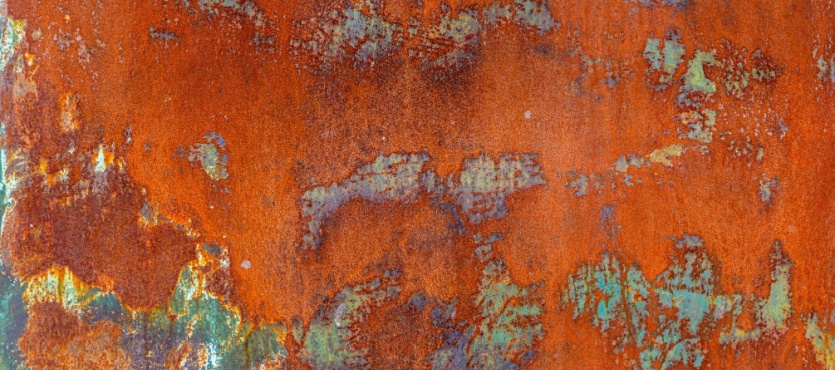Rust is more than just an unsightly reddish-brown stain—it’s the visible result of a complex chemical reaction that can quietly eat away at metal structures and machinery. Understanding the science behind rust is essential for businesses and facility managers who want to protect their assets, especially in environments prone to high humidity, salt exposure, or chemical contact. By learning how rust forms and spreads, businesses can take smarter steps toward prevention and long-term maintenance.
What Is Rust?
Rust is a specific type of corrosion that occurs when iron or steel reacts with oxygen and water. This process, known as oxidation, leads to the formation of iron oxide—a flaky, brittle compound that weakens the underlying metal. While all corrosion involves chemical reactions that deteriorate materials, rust specifically refers to corrosion involving iron-based metals.
The chemical reaction that produces rust looks like this:
4Fe + 3O₂ + 6H₂O → 4Fe(OH)₃
This equation represents how iron (Fe), when exposed to oxygen (O₂) and water (H₂O), forms iron hydroxide (Fe(OH)₃), which later dehydrates into iron oxide (Fe₂O₃), the familiar rust substance.
Conditions That Accelerate Rust
While rust can form in any environment with oxygen and moisture, certain conditions significantly speed up the process. High humidity promotes oxidation by providing a consistent moisture source in the air. Florida’s climate, for example, presents a near-perfect environment for rust to thrive year-round. Salt exposure, especially near coastal regions or from de-icing materials, further accelerates rust formation by acting as an electrolyte, which enhances the chemical reaction. Acidic environments, including areas with chemical exposure, can strip protective layers from metal, leaving them more vulnerable. Finally, frequent temperature changes cause condensation, adding moisture to surfaces and encouraging rust to take hold.
Why Rust Is So Destructive
Once rust begins to form, it doesn’t stop—it continues to corrode the surface and spread deeper into the material. This process flakes away protective coatings and exposes fresh metal, which then oxidizes and continues the cycle. Over time, rust compromises the structural integrity of equipment, metal supports, and other components critical to industrial and commercial operations.
Rust also expands as it forms, which can cause joints to seize up, fasteners to break, and seals to fail. In mechanical systems, this can lead to costly inefficiencies, system malfunctions, and dangerous safety hazards. Rust-related failures often go unnoticed until they cause serious disruptions, which is why corrosion is considered a silent but powerful threat.
Types of Rust
Understanding the different forms of rust helps identify the most appropriate treatment and prevention methods. Uniform rust affects large areas evenly, typically found on flat or exposed metal surfaces. Pitting corrosion is more localized but far more damaging—it eats into the metal in small, deep pits that can be difficult to detect until a failure occurs. Crevice corrosion develops in tight, hard-to-reach spaces where water collects and ventilation is limited. Galvanic corrosion happens when two dissimilar metals come into contact in the presence of an electrolyte, causing one metal to corrode faster than the other.
Preventing Rust Through Science
Science offers several reliable methods for preventing rust, each based on disrupting the chemical reaction that leads to corrosion. Protective coatings, such as paints and primers, create a barrier that keeps moisture and oxygen away from the metal. Some coatings are formulated with rust inhibitors that slow down the oxidation process, making them even more effective over time.
Cathodic protection is another method, commonly used in pipelines and marine structures. This technique connects the metal to a more easily corroded “sacrificial” metal that absorbs the corrosion instead, preserving the integrity of the primary structure. Environmental control also plays a role—reducing humidity, improving airflow, and limiting chemical exposure helps prevent the conditions that allow rust to develop.
Choosing corrosion-resistant materials, such as stainless steel or aluminum, is a smart long-term strategy for many industries. These metals either form their own protective oxide layers or are less reactive in the presence of oxygen and moisture. Regular maintenance is also critical. Inspections, cleaning, and reapplying protective treatments are key to stopping rust before it spreads and becomes a larger issue.
Applying Science for Smart Rust Prevention
Rust is the result of a well-understood chemical process, but its consequences can be unpredictable and costly if ignored. By understanding the science of rust, businesses can take informed steps to prevent corrosion, protect valuable equipment, and extend the lifespan of their infrastructure. Proactive measures reduce the risk of failure, improve operational efficiency, and minimize expenses tied to unexpected repairs and replacements.
If rust is already affecting your facility or equipment, RustyGone offers expert removal and prevention services backed by proven science. Trust our team to help you stop rust at its source and keep your operations running smoothly.

